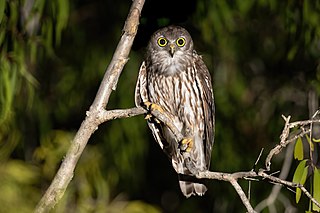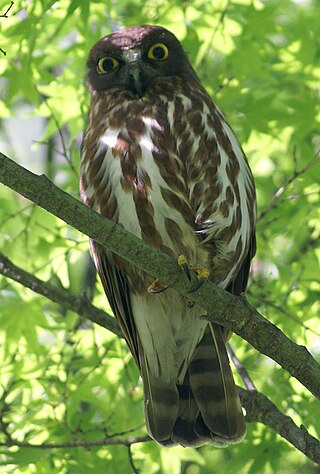
The morepork, also called the mopoke or the ruru, is a small brown owl found in New Zealand, Norfolk Island and formerly Lord Howe Island. The bird has almost 20 alternative common names, including mopoke and boobook—many of these names are onomatopoeic, as they emulate the bird's distinctive two-pitched call. Three subspecies of the morepork are recognized, one of which is extinct and another that exists only as a hybrid population.

The brown boobook, also known as the brown hawk-owl, is an owl which is a resident breeder in south Asia from India, Sri Lanka, Bhutan, Bangladesh and Nepal east to western Indonesia and south China.

The Australian boobook, is a species of owl native to mainland Australia, southern New Guinea, the island of Timor, and the Sunda Islands. Described by John Latham in 1801, it was generally considered to be the same species as the morepork of New Zealand until 1999. Its name is derived from its two-tone boo-book call. Eight subspecies of the Australian boobook are recognized, with three further subspecies being reclassified as separate species in 2019 due to their distinctive calls and genetics.

The barking owl, also known as the winking owl, is a nocturnal bird species native to mainland Australia and parts of New Guinea and the Moluccas. They are a medium-sized brown owl and have a characteristic voice with calls ranging from a barking dog noise to an intense human-like howl.

The Australian masked owl is a barn owl of Southern New Guinea and the non-desert areas of Australia.

The powerful owl, a species of owl native to south-eastern and eastern Australia, is the largest owl on the continent. It is found in coastal areas and in the Great Dividing Range, rarely more than 200 km (120 mi) inland. The IUCN Red List of Threatened Species also refers to this species as the powerful boobook.

The WestSolomons owl, also referred to as the West Solomons boobook, is a small to medium-sized owl, measuring 23–31 cm (9.1–12.2 in) in length. Its upperparts are rusty brown, sometimes spotted or barred with white, its chest is buffy white, sometimes spotted or barred with brown, and its creamy belly is unmarked. It has a grayish-brown facial disc, edged by narrow white eyebrows and a band of white across the throat.

The Cape eagle-owl is a species of owl in the family Strigidae. It is one of several large species of the eagle-owl genus Bubo.

The Christmas boobook, also known more specifically as the Christmas Island hawk-owl, is a species of owl in the family Strigidae.

The hooded robin is a small passerine bird native to Australia. Like many brightly coloured robins of the Petroicidae, it is sexually dimorphic; the male bears a distinctive black-and-white plumage, while the female is a nondescript grey-brown.

The Norfolk boobook, also known as the Norfolk Island boobook, Norfolk Island owl or Norfolk Island morepork, is a bird in the true owl family endemic to Norfolk Island, an Australian territory in the Tasman Sea between Australia and New Zealand. It is a subspecies of the morepork.

The Lord Howe boobook, also known as the Lord Howe morepork, was a bird in the true owl family endemic to Lord Howe Island in the Tasman Sea, part of New South Wales, Australia. It is an extinct and little-known subspecies of the morepork.

The northern boobook belongs to the family Strigidae and is a raptorial owl endemic to eastern and southern countries of Asia. The species was considered, until recently, a conspecific of Ninox scutulata or brown boobook, a species of similar distribution encompassing 11 subspecies. The species currently includes two subspecies, the migrant Ninox japonica japonica and the non-migrant Ninox japonica totogo. Despite being considered as the most common breeding owl in Japan, little research has been conducted on the species and subspecies and the taxonomic classification of N. j. totogo and N. j. japonica has been a subject of debate. There are no indications of significant decline in northern boobook populations and therefore its conservation status has been classified as least concern by the IUCN Red List.

The Luzon boobook or Luzon hawk-owl is a species of owl in the family Strigidae. It is endemic to the Philippines where it lives in forests. It is a brown and white mottled bird and males and females look much alike.
The Mindanao boobook or Mindanao hawk-owl is a species of owl in the family Strigidae that is endemic to the Philippines on the island of Mindanao. It was previously known as a subspecies of the Philippine hawk-owl, but was reclassified in 2012, as voice and other evidence suggested it a distinct species. It is found in tropical moist lowland forest. It is threatened by habitat loss.
The Romblon boobook or Romblon hawk-owl, is a species of owl in the family Strigidae that is endemic to the Philippines. It is only found on the islands of Tablas, Sibuyan and Romblon. It was previously known as a subspecies of the Philippine hawk-owl, but was reclassified in 2012, as voice and other evidence suggested it was a distinct species. Its natural habitat is tropical moist lowland forest. It is threatened by habitat loss.
The Timor boobook is a species of owl in the family Strigidae. It is found on Timor, Roma, Leti and Semau Islands in the eastern Lesser Sunda Islands of Indonesia.














